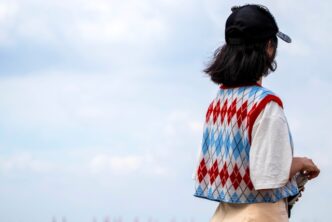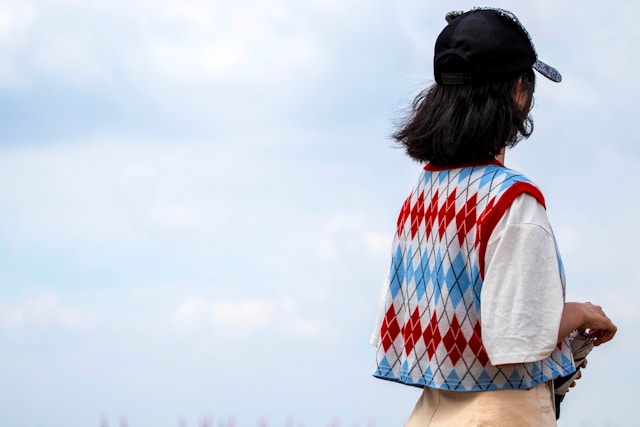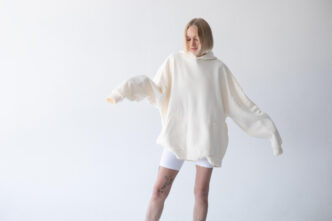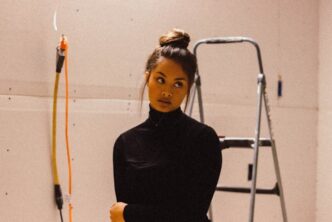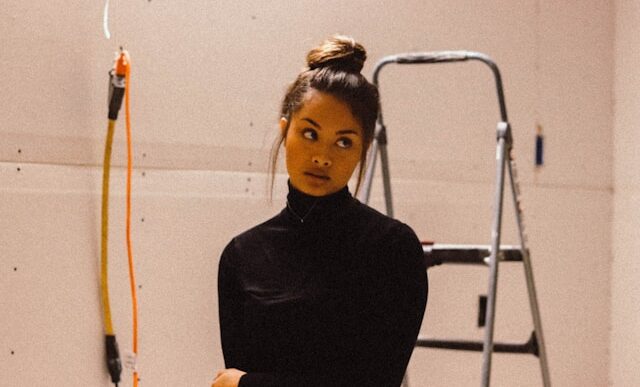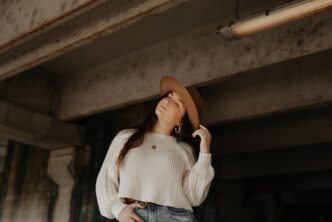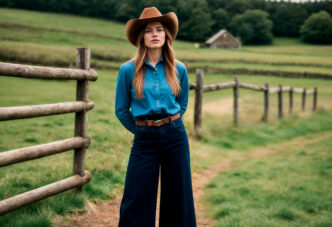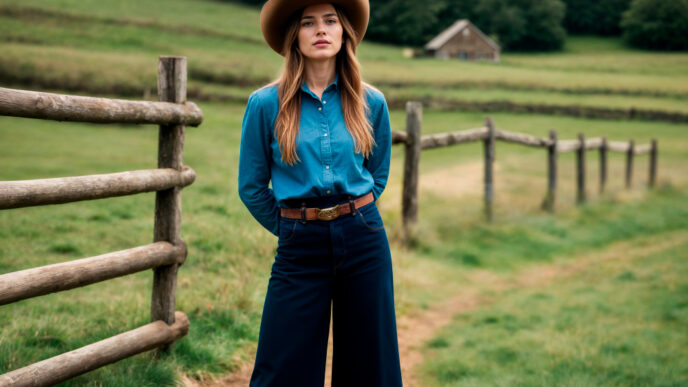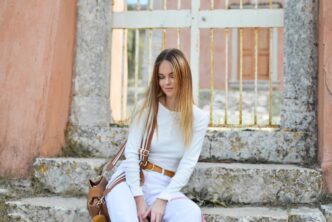Sweater vests have become essential wardrobe pieces for modern women. These versatile garments offer layering options while maintaining polished appearances. The sleeveless design provides warmth without bulk. This guide explains how to style sweater vest pieces effectively across seasons. You will discover outfit combinations that work for various occasions. The article covers different vest styles and provides practical styling advice. Whether you are new to this trend or seeking fresh inspiration, these suggestions will help create sophisticated looks.
Top 10 Sweater Vest Outfit Ideas
Sweater vests create excellent foundations for versatile styling approaches. The layering potential makes them suitable for numerous occasions and weather conditions. These curated outfit ideas demonstrate different ways to incorporate vests into your wardrobe.
Sweater Vest with White Button-Down Shirt
Pairing a sweater vest with a crisp white button-down creates a classic preppy aesthetic. This combination works beautifully for professional settings and polished casual occasions. The contrast between structured shirt and soft vest adds visual interest while maintaining sophistication.
Choose button-down shirts that fit properly through the shoulders and bust. The collar should lay flat under the vest without bunching. Cotton or cotton blend shirts provide the best foundation for this layered look. White remains the most versatile choice, though light blue works well too.
The vest should fit comfortably over the shirt without pulling or creating bulk. V-neck styles work particularly well with button-downs, as they showcase the collar and create flattering necklines. Crew neck vests can work but may appear too casual for professional settings.
Complete this sweater vest outfit for women with tailored trousers or a pencil skirt. Pointed-toe flats or low heels maintain the polished aesthetic. Add simple jewelry like pearl earrings or a delicate watch. This combination demonstrates how traditional pieces can create timeless, professional looks.
The layering technique requires attention to proportion. Tuck the shirt completely into your bottom piece, ensuring smooth lines under the vest. The vest length should hit at your natural waist or slightly below for the most flattering silhouette.
Sweater Vest with T-Shirt and Jeans
A casual t-shirt layered under a sweater vest creates relaxed yet put-together looks. This combination works perfectly for weekend activities and casual outings. The contrast between casual base layer and structured vest strikes an appealing balance.
Select fitted t-shirts in neutral colors like white, gray, or navy. The t-shirt should be long enough to tuck into your jeans while remaining comfortable under the vest. Quality cotton provides the best feel and maintains shape through wear and washing.
Styling options vary with this combination. Try tucking just the front of the t-shirt for a casual approach. Complete tucking creates more structure. Leaving everything untucked works for very relaxed occasions but may appear sloppy if not executed carefully.
Denim choices significantly impact the overall aesthetic. Dark wash jeans create more polished appearances, while lighter washes emphasize the casual nature. Straight leg or bootcut styles work best with this combination, avoiding extreme silhouettes that compete with the vest.
This sweater vest outfits approach works well with white sneakers for ultimate casualness or ankle boots for added structure. Simple accessories like a crossbody bag and minimal jewelry complete the look without overwhelming the layered elements.
Sweater Vest with Midi Skirt
Combining a sweater vest with a midi skirt creates feminine, sophisticated outfits suitable for various occasions. This pairing works particularly well for transitional seasons when you need warmth without heavy layers. The contrast between structured vest and flowing skirt provides visual interest.
Choose midi skirts in flattering cuts that complement your body type. A-line styles work universally well, while pencil skirts create more formal appearances. Pleated options add texture and movement that complement the vest’s structured nature.
Color coordination plays a crucial role in this combination’s success. Neutral vests pair beautifully with patterned or colored skirts. Matching tones create monochromatic looks that appear sophisticated and intentional. Contrasting colors can work but require careful consideration.
The vest fit should be tailored enough to define your waist while allowing comfortable movement. Cropped styles work particularly well with high-waisted midi skirts, creating flattering proportions that elongate the legs and define the waistline effectively.
Complete this women’s sweater vest outfit with heeled pumps or ankle boots depending on the season. Delicate jewelry and a structured handbag add polish without competing with the layered textures. This combination shows how feminine pieces can work with structured vests.
Sweater Vest with Wide-Leg Trousers
Wide-leg trousers paired with a fitted sweater vest create balanced proportions while maintaining comfort. This combination works well for professional settings and sophisticated casual occasions. The contrast between fitted top and flowing bottom creates visually appealing silhouettes.
Select wide-leg trousers in quality fabrics that drape well and maintain their shape throughout the day. Wool blends work beautifully for cooler weather, while cotton or linen options suit warmer months. The rise should be high enough to tuck in any base layers comfortably.
The sweater vest should fit closely through the torso to balance the volume of wide-leg pants. Avoid oversized vests that might create boxy silhouettes. V-neck styles typically work better than crew necks with this combination, as they create longer lines.
Layering underneath requires careful consideration. A fitted long-sleeve tee or thin blouse works well as a base layer. The sleeves should be slim enough to fit comfortably under the vest without creating bulk around the armholes.
This how to style sweater vest approach works beautifully with pointed-toe flats or low-heeled mules. The streamlined footwear complements the flowing trousers while maintaining sophistication. Add structured accessories like a leather handbag and simple jewelry to complete the polished look.
Sweater Vest with Pleated Skirt
A pleated skirt paired with a sweater vest creates scholarly, vintage-inspired looks that feel both classic and contemporary. This combination works particularly well for academic settings, creative workplaces, and sophisticated casual occasions. The textural contrast adds visual interest.
Choose pleated skirts in lengths that flatter your proportions. Knee-length options work universally well, while longer styles suit taller frames. The pleats should lay flat and move naturally with your body. Wool or cotton blends typically hold pleats better than synthetic fabrics.
The vest should complement the skirt’s structure without competing. Solid colors work best with patterned pleated skirts, while textured vests can pair beautifully with solid-colored skirts. Cable knit or ribbed textures add visual interest without overwhelming.
Layering options vary with this combination. A thin turtleneck under the vest creates sophisticated looks perfect for cooler weather. Long-sleeve blouses work well for professional settings, while simple tees keep the look casual and accessible.
Complete this how to wear sweater vest styling with oxford shoes, loafers, or low-heeled pumps. The footwear choice affects the overall formality level. Add a structured bag and classic jewelry pieces like pearl earrings or a simple watch for timeless appeal.
Sweater Vest with Leather Pants
Leather pants paired with a soft sweater vest create interesting textural contrasts that feel both edgy and sophisticated. This combination works well for evening occasions and creative professional settings. The mixing of tough and soft elements creates compelling visual dynamics.
Select leather pants in flattering cuts that provide comfortable movement. Straight leg or slight bootcut styles work best with vests, avoiding extreme silhouettes. Black remains the most versatile choice, though brown or burgundy can create unique looks with appropriate vest colors.
The sweater vest should provide soft contrast to the leather’s structure. Cashmere or soft wool blends work beautifully, offering luxurious textures that elevate the overall look. Avoid overly chunky knits that might appear unbalanced with sleek leather.
Layering underneath requires consideration of the leather pants’ fit. Fitted base layers work best to prevent bulk. Thin turtlenecks create sophisticated lines, while simple tank tops keep the focus on the textural contrast between vest and pants.
This types of sweater vest for women approach works beautifully with heeled ankle boots or pointed-toe pumps. The elevated footwear complements the edgy aesthetic while maintaining sophistication. Add minimal jewelry and a structured clutch for evening occasions.
Sweater Vest with Maxi Dress
Layering a sweater vest over a maxi dress creates bohemian-inspired looks that work well for transitional seasons. This unexpected combination adds structure to flowing dresses while providing warmth without bulk. The layering creates interesting proportional play.
Choose maxi dresses in fitted bodices that won’t create bulk under the vest. Wrap styles, fitted tops, or structured bodices work best. The dress should be long enough to create proper proportions with the vest while maintaining the maxi silhouette.
The vest length becomes crucial with this combination. Cropped styles that hit at the natural waist work best, creating defined waistlines while allowing the dress to flow properly. Longer vests can overwhelm the dress proportions and should be avoided.
Color coordination requires careful consideration with this layered approach. Neutral vests work with patterned dresses, while tonal combinations create sophisticated monochromatic looks. Contrasting colors can work but need thoughtful selection to avoid clashing.
Complete this what to wear with sweater vest styling with ankle boots for casual occasions or heeled sandals for dressier events. Layered jewelry and a crossbody bag complement the bohemian aesthetic while maintaining sophistication and practical functionality.
Sweater Vest with Cropped Pants
Cropped pants paired with sweater vests create modern, polished looks perfect for professional settings and sophisticated casual occasions. This combination showcases footwear while maintaining coverage and warmth through the torso. The proportions work well for most body types.
Select cropped pants in flattering cuts that hit at the right point on your leg. The hem should typically fall just above the ankle bone for the most flattering effect. Straight leg or slight bootcut styles work best with vests, creating clean lines.
The vest fit should be tailored enough to define your waist while allowing comfortable layering underneath. Avoid overly loose fits that might appear sloppy with the structured nature of cropped pants. The length should complement the pants’ proportions.
Base layer choices affect both comfort and appearance. Fitted long-sleeve tees work well for casual styling, while thin blouses create more professional looks. The sleeves should fit comfortably under the vest without creating bulk around the armholes.
This sweater vest outfit ideas for women approach showcases footwear beautifully. Pointed-toe flats create polished casual looks, while heeled pumps add formality. Ankle boots work well for transitional seasons, providing both style and practical warmth for exposed ankles.
Sweater Vest with Denim Skirt
A denim skirt paired with a sweater vest creates casual yet polished looks that work well for weekend activities and relaxed social occasions. This combination balances structured and casual elements effectively. The contrast in textures adds visual interest to simple outfits.
Choose denim skirts in flattering cuts and appropriate lengths for the occasion. A-line styles work universally well, while pencil cuts create more structured appearances. The wash should complement your vest color while maintaining the casual aesthetic.
The vest should provide nice contrast to the denim’s casual nature. Finer knits like cashmere or merino wool elevate the overall look, while chunky textures might appear too casual. Color choices significantly impact the sophistication level of this combination.
Layering options vary based on the desired formality level. Simple tank tops keep the look casual and appropriate for warm weather. Long-sleeve tees work well for transitional seasons, while thin turtlenecks can add sophistication for evening occasions.
Complete this how to dress up sweater vest styling with canvas sneakers for ultimate casualness or ankle boots for added structure. Simple jewelry and a crossbody bag maintain the relaxed aesthetic while adding personal style elements and practical functionality.
Sweater Vest with Palazzo Pants
Palazzo pants paired with a fitted sweater vest create flowing, comfortable outfits that work well for casual occasions and creative professional settings. This combination balances structure and fluidity effectively. The contrast in silhouettes creates visually interesting proportions.
Select palazzo pants in fabrics that drape well and move gracefully with your body. Lightweight wools, crepes, or quality synthetics work beautifully. The waistband should be comfortable and provide smooth lines under the fitted vest without creating bulk.
The vest fit becomes crucial with flowing bottoms. A tailored, body-skimming fit works best to balance the palazzo pants’ volume. Avoid loose-fitting vests that might create shapeless silhouettes when combined with wide-leg bottoms.
Base layer considerations include both comfort and appearance factors. Fitted tank tops work well in warmer weather, while thin long-sleeve tees provide coverage for cooler conditions. The base should be slim enough to layer comfortably under the vest.
This sweater vest style tips approach works beautifully with flat sandals for casual occasions or low heels for dressier events. The flowing pants create elegant movement that complements both footwear choices. Add delicate jewelry and a soft handbag to complete the flowing aesthetic.
Types and Styles of Sweater Vests
Understanding different sweater vest styles helps you select the most flattering options for your body type and lifestyle needs. The sleeveless design comes in numerous variations, each offering unique styling possibilities and aesthetic appeals.
Classic V-neck sweater vests remain the most versatile and universally flattering option. The V-neckline creates elongating effects while providing excellent opportunities for layering various tops underneath. This style works beautifully with button-down shirts, creating preppy professional looks, or with simple tees for casual styling approaches.
The depth of the V-neck significantly affects the overall appearance and styling options. Moderate V-necks work well for professional settings and provide excellent layering opportunities. Deeper V-necks create more dramatic looks but require careful consideration of underlying garments to maintain appropriateness.
Crew neck sweater vests offer more coverage and create different aesthetic effects than V-neck styles. These vests work particularly well for casual styling and provide excellent options for those who prefer more modest necklines. The higher neckline creates cleaner lines with certain outfit combinations.
The crew neck style requires more careful layering consideration, as high necklines can appear bulky if not styled properly. Thin base layers work best, and the overall proportions need attention to avoid creating unflattering silhouettes around the neck and shoulder areas.
Turtleneck sweater vests create sophisticated, polished looks that work beautifully for professional settings and elegant casual occasions. The high neckline provides warmth while eliminating the need for additional layering pieces. This style works particularly well in transitional seasons when extra neck coverage becomes beneficial.
The fitted nature of turtleneck vests requires attention to body proportions. The style works best on those with longer necks and slender frames. The high neckline can be overwhelming on shorter torsos or broader shoulders without careful styling consideration.
Cropped sweater vests hit at or above the natural waistline, creating opportunities for high-waisted bottom pieces and defined silhouettes. This modern style works particularly well with flowing skirts, wide-leg pants, or high-waisted jeans. The shorter length creates interesting proportional play.
The cropped length requires careful consideration of underlying garments and bottom piece choices. High-waisted pieces work best to avoid creating gaps between the vest and bottom items. The style works particularly well for creating defined waistlines and elongating leg proportions.
Cable knit sweater vests feature textured surfaces that add visual interest and dimensional quality to outfits. The raised patterns create sophisticated textures that work well with smooth fabrics like silk shirts or cotton tees. This style adds visual weight and works best balanced with simpler pieces.
The textural quality of cable knits requires consideration of overall outfit balance. Pairing with solid colors typically works better than mixing with other patterns or textures. The dimensional quality adds sophistication to simple outfit combinations while maintaining versatility.
Ribbed sweater vests create vertical lines that can be flattering for many body types. The subtle texture adds interest without overwhelming other outfit elements. This style works well for both casual and professional styling, providing versatility across different occasions and seasons.
The vertical ribbing creates elongating effects that can be particularly flattering. The texture is subtle enough to work with various layering pieces without creating competing visual elements. This makes ribbed vests excellent foundational pieces for versatile wardrobes.
Argyle patterned sweater vests create preppy, academic-inspired looks that work well for professional settings and sophisticated casual occasions. The diamond pattern adds visual interest while maintaining classic appeal. This style works particularly well with solid-colored layering pieces.
The pattern requires careful coordination with other outfit elements. Solid colors work best underneath to avoid competing patterns. The classic nature of argyle makes these vests excellent investment pieces that remain stylish across fashion cycles.
Fair Isle and Nordic patterned vests bring cultural and seasonal elements to outfits. These patterns work particularly well during autumn and winter months, adding visual warmth and textural interest. The traditional patterns create cozy, sophisticated aesthetics.
The busy nature of these patterns requires careful styling to avoid overwhelming outfits. Simple, solid-colored base layers work best to allow the patterns to be focal points. These vests work well as statement pieces in otherwise simple outfit combinations.
How To Choose The Best Sweater Vest
Selecting the perfect sweater vest requires attention to fit, fabric quality, style preferences, and intended use. The goal involves finding pieces that flatter your body type while providing versatility for various styling approaches and occasions.
Start by determining which neckline styles work best for your body type and personal preferences. V-necks typically provide the most versatility and work well with various layering pieces. The depth should complement your proportions while providing appropriate coverage for different settings.
Consider your typical layering needs when selecting neckline styles. If you frequently wear button-down shirts, V-necks provide excellent compatibility. For those who prefer simpler layering with tees or tanks, crew necks might offer better proportion balance and styling simplicity.
Fit considerations prove crucial for both comfort and appearance. The vest should skim your body without being too tight or loose. Armholes should provide comfortable movement without gaping. The shoulder seams should hit at your natural shoulder point for the most flattering silhouette.
Pay attention to length proportions when trying on different styles. The hem should hit at a flattering point on your torso, typically at or slightly below your natural waist. Longer lengths can be overwhelming on petite frames, while shorter styles might not provide adequate coverage for all body types.
Fabric quality significantly impacts both appearance and longevity. Natural fibers like wool, cashmere, or cotton blends typically provide the best combination of comfort, durability, and appearance. These materials also tend to layer better and maintain their shape through wear and cleaning.
Consider the intended use when evaluating fabric choices. Professional settings might require finer fabrics like merino wool or cashmere, while casual wear allows for more relaxed textures. The fabric weight should be appropriate for your climate and typical layering needs.
Color selection affects versatility and coordination with existing wardrobe pieces. Neutral colors like navy, gray, cream, or black provide maximum styling flexibility and work well with various layering pieces and bottom options. These colors also tend to remain stylish across fashion cycles.
Consider your existing wardrobe when selecting colors to ensure the vest will coordinate well with pieces you already own. Classic colors provide better investment value than trendy shades that might quickly become outdated or difficult to coordinate with other garments.
Seasonal Style Guide for Sweater Vests
Sweater vests adapt beautifully to seasonal styling changes, offering versatility throughout the year with appropriate layering and fabric choices. Understanding how to modify your approach ensures maximum wearability across different weather conditions and seasonal fashion expectations.
Spring styling emphasizes lighter fabrics and fresh colors that reflect the season’s renewal energy. Choose cotton or lightweight wool vests in soft pastels or classic neutrals. Layer over thin long-sleeve tees or light blouses for comfortable temperature regulation as spring weather fluctuates throughout the day.
Light-colored vests work particularly well during spring months, pairing beautifully with white jeans, light-wash denim, or flowing skirts. The layering provides warmth during cooler mornings while remaining comfortable as temperatures rise during the day.
Footwear choices for spring include canvas sneakers, ballet flats, and low-heeled sandals that complement the fresh, optimistic aesthetic. Light accessories like delicate jewelry and crossbody bags complete spring looks without adding unnecessary weight or visual heaviness.
The transitional nature of spring weather makes vests particularly practical, providing just enough warmth without the bulk of heavier layers. This makes them excellent choices for unpredictable spring conditions that can change throughout the day.
Summer approaches require careful fabric selection to maintain comfort in warmer weather. Choose lightweight cotton or linen blend vests that provide coverage without excessive warmth. Sleeveless base layers like tank tops work well underneath, creating minimal layers.
Light colors and breathable fabrics become essential during summer months. White, cream, and pale pastels reflect heat while maintaining style. Pair with shorts, cropped pants, or lightweight skirts for optimal comfort in hot weather conditions.
Summer styling focuses on maintaining coverage while prioritizing cooling comfort. The vest provides sun protection for shoulders and upper torso while allowing air circulation through the arms. This makes them practical choices for air-conditioned environments where light layering becomes necessary.
Footwear during summer emphasizes breathability and comfort. Canvas shoes, sandals, and lightweight flats work well with summer vest styling. Keep accessories minimal and functional, focusing on pieces that enhance rather than add heat to your overall comfort.
Autumn styling allows for richer colors and additional layering opportunities that showcase vests’ versatility. Deeper tones like burgundy, forest green, and rust work beautifully with the season’s changing landscape. Layer over fitted turtlenecks or long-sleeve tees for increased warmth.
Wool and cashmere vests become particularly appealing during autumn months, providing luxurious textures and appropriate warmth for cooler temperatures. The layering opportunities expand significantly, allowing for creative combinations with various base layers and outer pieces.
Autumn color palettes complement the natural textures of quality sweater vests. Earth tones and jewel colors work particularly well, creating sophisticated looks that reflect the season’s more serious aesthetic expectations while maintaining comfort and practicality.
Footwear choices expand during autumn to include ankle boots, loafers, and closed-toe options that provide warmth while maintaining style compatibility with vest styling. These choices support the season’s more structured approach to dressing while maintaining comfort.
Winter styling requires strategic layering to maximize warmth while maintaining the vest’s aesthetic appeal. Choose heavier wool or cashmere vests that provide substantial warmth when layered over long-sleeve base layers. Add coats or jackets over the vest for complete weather protection.
Darker colors work particularly well during winter months, providing sophistication while hiding potential weather-related wear. Navy, black, charcoal, and deep burgundy create elegant foundations for winter layering while maintaining professional appropriateness.
The layering potential of vests becomes particularly valuable during winter months when multiple layers become necessary for comfort. The sleeveless design prevents bulk around the arms while providing core warmth, making them excellent middle layers in comprehensive winter wardrobes.
Do’s and Don’ts of Wearing Sweater Vests
Understanding key principles for wearing sweater vests successfully helps create flattering, stylish outfits while avoiding common mistakes. These guidelines provide foundation knowledge for styling vests with confidence across various occasions and seasons.
Do pay attention to proper fit through the armholes and torso areas. The vest should skim your body comfortably without pulling or creating unflattering lines. Armholes should allow comfortable movement without gaping, and shoulder seams should hit at your natural shoulder point for the most flattering appearance.
Proper fit forms the foundation for all successful vest styling. When the base fit is correct, all other styling elements work more effectively together. Take time to find your correct size and consider trying different brands to find the best fit for your body type.
The vest should provide enough room for comfortable layering underneath without appearing oversized or baggy. This balance ensures both comfort during wear and attractive appearance that looks intentional rather than ill-fitting or accidentally oversized.
Do consider the occasion and dress code when selecting and styling sweater vests. While versatile, vests work better in some settings than others. Professional environments often welcome well-styled vests, while very formal occasions might require different approaches.
Understanding appropriate contexts for vest wearing ensures you make suitable choices for different situations. Creative workplaces, academic settings, and business casual environments typically provide excellent opportunities for showcasing well-styled vest combinations.
Consider the formality level of your overall outfit when styling vests. The layering pieces, bottom choices, and accessories significantly impact whether the final look appears casual, professional, or somewhere in between these categories.
Do invest in quality vests made from good materials that will maintain their appearance and shape over time. Natural fibers typically provide the best combination of comfort, durability, and visual appeal. Quality construction ensures the vest maintains its intended silhouette through wear and cleaning.
Well-made vests provide better layering capabilities and tend to look more polished than cheaper alternatives. The investment in quality pays off through improved appearance, longer wear life, and greater versatility in styling applications across different occasions.
Quality materials also tend to layer better with other garments, creating smoother lines and more comfortable wear experiences. This becomes particularly important when building layered outfits that need to remain comfortable throughout long wear periods.
Do experiment with different layering combinations to discover what works best for your body type and style preferences. Vests offer numerous layering possibilities, and finding your preferred approaches requires some experimentation with various base layers and styling techniques.
Try different combinations of base layers, from simple tees to button-down shirts to turtlenecks. Each creates different aesthetic effects and comfort levels, allowing you to build a repertoire of go-to combinations for different occasions and weather conditions.
The experimentation process helps you understand which combinations feel most comfortable and appear most flattering, building confidence in wearing vests across various situations and styling them successfully for different needs.
Don’t choose vests that are too tight or too loose, as either extreme creates unflattering appearances and comfort issues. Overly tight vests can create pulling and unflattering lines, while too-loose options appear sloppy and fail to provide the structured layering effect that makes vests appealing.
The fit should allow comfortable layering underneath without creating bulk or restriction. Pay particular attention to the armhole fit, as this area is crucial for both comfort and appearance when layering different pieces together.
Proper fit ensures that the vest serves its intended purpose of providing structured layering while maintaining comfort and attractive appearance throughout extended wear periods in various activities and settings.
Don’t ignore the importance of coordinating colors and textures when building vest outfits. While mixing different elements can create interesting looks, successful combinations require thoughtful consideration of how different pieces work together visually and aesthetically.
Consider the overall balance of colors, patterns, and textures in your complete outfit. Solid vests typically work better with patterned base layers, while textured vests might pair better with smooth fabrics to avoid competing visual elements.
The coordination extends beyond just the vest and immediate base layer to include bottom pieces, footwear, and accessories. All elements should work together to create cohesive, intentional appearances rather than accidentally mismatched combinations.
Don’t wear sweater vests in inappropriate settings where they might appear too casual or out of place. Very formal events, black-tie occasions, or extremely conservative professional environments might not be suitable contexts for vest styling.
Understanding the limitations helps you make appropriate choices about when to incorporate vests into your outfits. Having alternative styling options available ensures you can dress appropriately for all occasions while still enjoying vests when suitable.
Consider the specific requirements and expectations of different settings when planning outfits that include vests. This awareness helps you make choices that are both stylish and contextually appropriate for various situations.
Don’t overlook the importance of proper care and maintenance for sweater vests. Quality materials require appropriate care to maintain their appearance and extend their useful life. Follow care instructions and store vests properly to prevent damage and maintain their shape.
Proper care ensures that your investment in quality vests pays off through extended wear and maintained appearance. Different materials require different care approaches, so understanding these needs protects your wardrobe investments effectively.
Regular maintenance and proper storage help prevent common issues like stretching, pilling, or shape distortion that can make even quality vests appear worn or shabby before their time.
8 Tips on How to Wear Sweater Vests
Mastering sweater vest styling requires understanding how to incorporate these versatile pieces effectively into various outfits and occasions. These essential tips help create polished, intentional looks that maximize vests’ styling potential while avoiding common pitfalls.
The first tip focuses on achieving proper layering balance with base garments that complement rather than compete with the vest. Choose fitted base layers that provide smooth foundations without creating bulk. Thin materials work best, allowing the vest to lay properly while maintaining comfort.
The base layer should be long enough to tuck in when necessary but not so long that it creates bunching or visible lines under the vest. Cotton, modal, or silk blends typically provide the best combination of comfort and layering compatibility.
Consider the neckline relationship between the vest and base layer. V-neck vests showcase collared shirts beautifully, while crew neck styles work better with simpler base layers that don’t compete for attention around the neckline area.
The second tip emphasizes the importance of proportion consideration when styling vests with different bottom pieces. Fitted vests work well with flowing bottoms like wide-leg pants or full skirts, while looser vest styles pair better with fitted bottoms for balanced proportions.
Understanding these proportional relationships helps create visually appealing outfits that flatter your body type. The contrast between fitted and flowing elements creates interest while maintaining flattering silhouettes that enhance rather than hide your natural proportions.
Consider your overall body proportions when making these styling decisions. Taller frames can handle more dramatic proportion contrasts, while petite builds might benefit from more moderate differences between fitted and flowing elements.
The third tip involves selecting appropriate colors that coordinate well with your existing wardrobe while providing maximum versatility. Neutral colors like navy, gray, and cream offer the most styling flexibility and work well across seasons and occasions.
These classic colors provide excellent foundations for building various outfit combinations while ensuring your vest investment provides long-term value. They coordinate well with both solid and patterned pieces, allowing for creative styling without limiting options.
Consider your skin tone and personal color preferences when selecting neutral shades. Different undertones work better with different neutral options, so choose shades that complement your natural coloring for the most flattering results.
The fourth tip focuses on fabric selection based on intended use and climate considerations. Natural fibers provide the best combination of comfort, appearance, and durability for most styling applications and weather conditions.
Wool and cashmere offer excellent warmth and luxurious textures for cooler weather, while cotton and linen blends work well for transitional seasons and milder climates. The fabric choice significantly impacts both comfort and styling possibilities.
Consider the care requirements of different fabrics when making selections. Some natural fibers require more careful maintenance, while others offer easier care options that might better suit busy lifestyles or frequent wear needs.
The fifth tip emphasizes the importance of occasion-appropriate styling that considers dress codes and social expectations. Professional settings often welcome well-styled vests, while casual occasions allow for more relaxed approaches to layering and coordination.
Understanding these contextual considerations helps ensure your vest styling choices are appropriate for different situations while maximizing the versatility of these pieces across various aspects of your lifestyle and professional needs.
Consider the overall formality level required by different occasions and adjust your styling approach accordingly. The same vest can work for multiple settings with different layering and accessory choices.
The sixth tip involves strategic accessory selection that complements rather than competes with the layered nature of vest outfits. Simple, classic pieces typically work best, allowing the layering to be the focal point while adding polish and personal style.
Avoid overly dramatic or competing accessories that might overwhelm the structured nature of vest styling. Delicate jewelry, classic handbags, and appropriate footwear choices enhance the overall look without creating visual chaos or distraction.
The accessories should support the overall aesthetic you’re trying to achieve, whether that’s professional polish, casual sophistication, or creative expression within appropriate boundaries for different settings and occasions.
The seventh tip focuses on understanding seasonal adaptation techniques that allow you to wear vests year-round with appropriate modifications for weather and seasonal style expectations. Layer selection and fabric choices become crucial for successful seasonal transitions.
Lighter fabrics and minimal layering work well for warmer months, while heavier materials and strategic layering create warmth and appropriate coverage for cooler seasons. Understanding these adaptations maximizes your vest investment across different times of year.
Consider seasonal color palettes and how they affect your vest styling choices. Lighter colors and materials work well for spring and summer, while richer tones and heavier fabrics suit autumn and winter styling approaches better.
The eighth tip emphasizes the importance of confidence and comfort when wearing sweater vests. These pieces require some confidence to wear successfully, as they represent a more structured approach to casual dressing that might feel unfamiliar initially.
Building comfort with vest styling comes through practice and experimentation with different combinations. Start with simpler styling approaches and gradually experiment with more creative layering as your confidence builds with wearing these versatile pieces.
Remember that well-styled vests can elevate simple outfits significantly while providing practical layering benefits. When you feel comfortable and confident in your styling choices, it shows in your overall presence and appearance.
Best Alternatives to Sweater Vests
While sweater vests offer unique layering and styling benefits, several alternatives provide similar aesthetic effects or functional advantages. Understanding these options helps expand your wardrobe while maintaining the structured, layered looks you appreciate in vest styling.
Cardigans represent the closest alternative to sweater vests, offering similar knit textures and layering capabilities with the added benefit of sleeves for additional coverage. Open-front cardigans create layering opportunities while providing more warmth than sleeveless options.
Choose cardigans in similar colors and textures to your preferred vest styles for comparable styling effects. The sleeve coverage makes them more versatile for varying weather conditions while maintaining the knit texture and layering appeal of vests.
Style cardigans over simple base layers with tailored bottoms for professional looks, or pair with casual pieces for relaxed weekend styling. The additional coverage makes them suitable for situations where sleeveless options might not provide adequate warmth or coverage.
Structured blazers offer professional alternatives that provide similar layering effects with more formal appearances. While different in texture and material, blazers create comparable proportional effects and work well for business settings where vests might appear too casual.
Select blazers in neutral colors and classic cuts for maximum versatility across different outfit combinations. The structured nature provides similar silhouette definition while offering more formal styling options for professional environments and dressy occasions.
Layer blazers over blouses, fitted tees, or thin sweaters depending on the desired formality level and weather requirements. The structured shoulders and lapels create different aesthetic effects than vests while providing comparable layering functionality.
Sleeveless blouses provide lightweight alternatives that offer coverage without bulk while maintaining the sleeveless silhouette that makes vests appealing. These pieces work particularly well in warmer weather when knit fabrics might be too warm for comfort.
Choose sleeveless blouses in quality fabrics like silk, cotton, or linen for professional styling that provides coverage without warmth. The flowing nature creates different silhouettes than fitted vests while maintaining the sleeveless appeal and layering potential.
Style sleeveless blouses tucked into tailored pants or skirts for professional looks, or wear untucked with jeans for casual styling. The lighter fabrics make them excellent choices for warm weather when vest textures might be uncomfortable.
Tunic tops offer relaxed alternatives that provide coverage and styling versatility without the fitted nature of traditional vests. These longer pieces work well for casual styling and provide options for those who prefer looser fits while maintaining structured appearances.
Select tunics in flattering lengths that work well with your preferred bottom pieces. The longer silhouette creates different proportional effects than vests while providing comfortable coverage and easy styling for various occasions and activities.
Layer tunics over fitted base layers or wear alone depending on the fabric weight and weather conditions. The relaxed fit makes them comfortable choices for casual occasions while maintaining enough structure to appear intentional and polished.
Conclusion
Sweater vests represent versatile wardrobe additions that bridge casual and professional styling needs effectively. This comprehensive sweater vest style guide has explored various approaches to incorporating these pieces into modern wardrobes while maximizing their styling potential across different occasions and seasons.
The key to successful vest styling lies in understanding proper layering techniques, proportion balance, and occasion-appropriate choices. By following the recommendations and tips outlined throughout this guide, you can create sophisticated outfits that showcase vests’ unique benefits while maintaining comfort and style. Remember that mastering vest styling requires practice and experimentation, but the versatility and polish they add to your wardrobe make the effort worthwhile for creating elevated, intentional looks.
